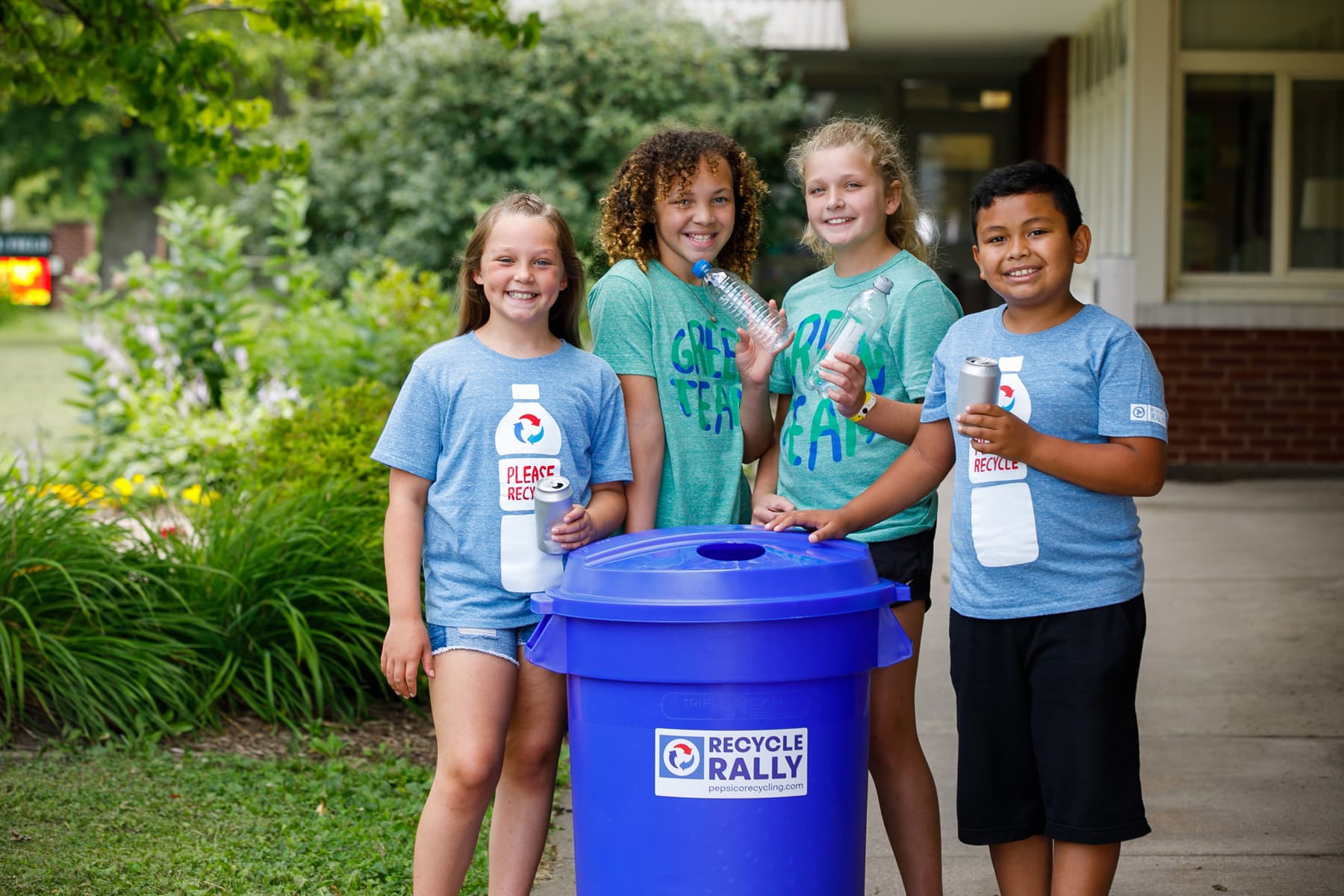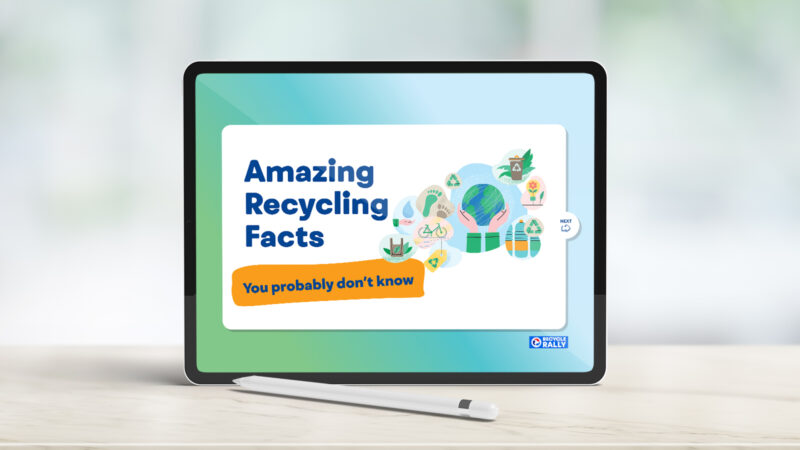Amazing Recycling Facts You Probably Don’t Know
Recycling one glass bottle saves enough energy to light a 100 watt light bulb for four hours.

Ready for some incredible recycling facts? According to Florida Tech, the U.S. is the #1 trash-producing country in the world, which means that 5% of the world’s people generate 40% of the world’s waste. The Environmental Protection Agency (EPA) reports that we recycle or compost only about one-third of that trash. The rest winds up in landfills (or worse, as pollution).
The best way to help is to reduce the number of items you use (by carrying a refillable water bottle instead of using plastic ones, for instance) or to reuse items like plastic bags or scrap paper. But it’s also important to properly recycle everything you possibly can. Here are some recycling facts to show you just how much recycling matters.
Recycling reduces landfill waste and prevents pollution.
There are about 1,900 landfills in the United States. Although most are carefully managed to prevent soil and water contamination, they still take up a lot of space and are often smelly. (No one wants to live next to the dump!) Recycling helps keep trash out of landfills and also cuts down on pollution. Take a look at these recycling facts to learn more.
- The average American throws away 4.9 pounds of trash per day. (EPA)
- An aluminum can that is thrown away today will still be an aluminum can 500 years from now. Plastic bottles last 700 years, and glass bottles as much as 4,000 years. (Florida Tech)
- Recycling soda cans creates 95% less air pollution and 97% less water pollution than making new ones. (MIT)
- One ton of recycled paper prevents 60 pounds of air pollutants. (MIT)
- Recycling one ton of cardboard saves over nine cubic yards of landfill space. That’s almost the size of three Olympic swimming pools. (MIT)
- The U.S. uses 14 TRILLION plastic bags a year. Only 1% of these are recycled. The rest wind up in landfills or as pollution. (Waste Management)
- Plastic bags and other plastic garbage thrown into the ocean kill as many as 1,000,000 sea creatures every year. (Florida Tech)
- The Great Pacific Garbage Patch, a vast collection of plastics and other marine debris, is estimated to weigh 3 million tons and covers an area twice the size of Texas. (Florida Tech)
Recycling saves energy, conserves natural resources, and reduces the risk of climate change.
When we recycle, we don’t need to harvest as many natural resources like trees, oil, and metal ores. It also takes less energy to recycle items than to make new ones from raw materials, and reducing energy use is one important way to prevent climate change. Recycling paper and cardboard helps to save trees, which are another key player in the climate change fight. Check out these recycling facts about energy, natural resources, and climate change.
- It takes a whopping 94% less energy to recycle aluminum cans than to make new ones from aluminum ore. (American Geosciences Institute)
- In 2018, 3.7 million tons of aluminum were produced by recycling in the United States, saving enough energy to provide electricity to 8 million homes. (American Geosciences Institute)
- Recycling one glass bottle saves enough energy to light a 100 watt light bulb for four hours. (Stanford University)
- The plastic used in one toner cartridge contains about a half quart of oil. (MIT)
- One ton of recycled plastic saves 16.3 barrels of oil. (Stanford University)
- Approximately 1 billion trees worth of paper are thrown away every year in the U.S. If Americans recycled all of their newspapers, we could save 250,000,000 trees a year. (Florida Tech)
- Each ton of recycled paper can save 17 trees, which can absorb a total of 250 pounds of carbon dioxide from the air each year. (Florida Tech)
Recycling of organic material is important too.
When we think of recycling, we generally think of cardboard, plastic bottles, and soda cans. But organic materials like food and yard trimmings can be recycled too! We call this composting, and it’s very good for the planet. The EPA says that composting enriches the soil and reduces the need for fertilizers. Here are some other compost recycling facts.
- In the United States, we waste as much as 30-40% of our food supply. (USDA)
- Food waste makes up nearly a quarter (24.14%) of the trash that winds up in landfills. (EPA)
- The U.S. composts 25 million tons of waste each year, or .42 pounds per person per day. Most of this (89%) is yard trimmings. (EPA)
- Composting reduces methane emissions from landfills, which accounts for more than 15% of overall methane emissions. (Methane is a greenhouse gas that accelerates climate change.) (EPA)
- The methane emissions from organic waste in landfills in 2018 were about the same as the greenhouse gas emissions from more than 20.6 million cars, trucks, and buses driven during one year. (EPA)
- One type of composting is called vermiculture, and it uses worms! One pound of red worms will eat half a pound of food waste every day. (EPA)
- A properly managed home compost bin does not attract pests or smell bad. You can make compost at home to use in your own gardens in about two to five weeks. (EPA)
Recycling contamination is a serious issue.
While recycling has a lot of benefits, it can cause problems too. When non-recyclable items end up in the recycling stream, it’s called “contamination.” Sometimes these items are sorted out ahead of time, but if they’re not, they can cause an entire batch of recyclable material to have to go into a landfill instead. These are some recycling facts you should know about contamination.
- One in four items placed in curbside recycling bins is not actually recyclable. That’s 25%!
- Plastic bags cannot go into most curbside bins, but they can be recycled. More than 18,000 stores provide plastic film drop-off locations in the U.S. (Plastic Film Recycling)
- Most glass is recyclable, but you should not place light bulbs in your recycling bin. Instead, you can take CFL or LED light bulbs to drop-off bins at many home improvement stores. (EPA)
- Food-stained paper products like pizza boxes can’t be recycled, but they might be able to be composted. (EPA)
- Not all curbside recycling programs accept plastic bottle caps, which are usually made of #5 plastic. Check with yours to see if you should leave them out. (Earth 911)
- Gift wrapping paper is often not able to be recycled because it has additives like glitter or laminated coating. Check with your waste management program to find out, and consider reusable wrapping materials like bags or fabric instead. (Recycle Now)
Take the Amazing Recycling Facts Kahoot! Quiz

Watch the Amazing Recycling Facts slideshow
Want to help your school become a recycling champion? Join Recycle Rally for lots of terrific ideas and resources!
Learn More

Recycle Rally
Recycle Rally is a free K-12 program that provides rewards and tools to help enhance recycling at your school!
Explore now
Additional Resources
Our comprehensive library of resources was designed to inspire the next generation of green leaders.
Explore now

